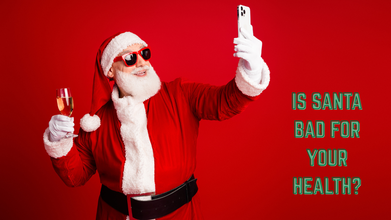- Health Conditions A-Z
- Health & Wellness
- Nutrition
- Fitness
- Health News
- Ayurveda
- Videos
- Medicine A-Z
- Parenting
Your Big Butt Might Be Making You Smarter- Science-Backed Reasons To Love Your Curves

Image Credit: Canva
Whether if it is the influence of social media, fashion, or societal expectations, most people fight to accept their natural body shape. For years, society imposed unattainable beauty standards, idealizing slender physiques and too often dismissing curvier physiques. What if the science were otherwise? What if having a large butt wasn't merely a matter of looks but had some unexpected health perks—ones that would make you stronger, healthier, and even smarter? Studies indicate that a more voluptuous backside isn't merely a style; it's a biological plus. From brain-enhancing advantages to improved heart health, your curves are doing you some good in ways you never thought possible. It's time to leave the insecurities behind and own the science-supported strength of your big booty!
Scientific studies indicate that where fat is deposited on your body has varying effects on your health. Contrary to visceral fat that is stored around the waist and contributes to severe health complications, fat deposited in hips, thighs, and butt is deemed favorable. This fat is referred to as subcutaneous fat, and research has indicated that it has a protective function in metabolic well-being. Additionally, scientists have discovered that people with greater lower-body fat stores have improved cardiovascular health, lower inflammation, and even greater cognitive function. Let's discuss the different science-supported advantages of having a large butt.
1. Lower Risk of Chronic Diseases
A more curvy lower body could be a protective factor against deadly diseases. A September 2020 meta-analysis in The BMJ concluded that people with a bigger hip and thigh circumference were less likely to die early in life compared to those who had fat around their waist. Fat in the buttocks releases healthy hormones, including adiponectin, which protects against heart disease, diabetes, and stroke. Furthermore, individuals who have a positive waist-to-hip ratio possess well-balanced cholesterol profiles, higher levels of good HDL cholesterol, and lower amounts of detrimental LDL cholesterol. Having such a balance decreases the risk for cardiovascular diseases and helps a person live a longer life.
2. A Brain-Boosting Advantage
Believe it or not, your big booty may be smarter than you think. A study in the International Journal of Obesity in 2010 discovered that women with bigger butts have greater amounts of omega-3 fatty acids, which are required for brain function. Omega-3s contribute to the construction of cell membranes of the brain and possess anti-inflammatory as well as antioxidant effects that facilitate mental health. For new mothers, stored fat becomes even more vital, as it delivers essential fatty acids to their infants through breast milk, adding to better brain development in kids.
3. Better Physical Performance
A strong posterior isn't all about appearance—it's the key to athletic performance. Your gluteus maximus is your body's biggest muscle, and it's what drives movements like running, stair climbing, and weightlifting. Powerful glutes give you stability, enhance balance, and create power for intense exercise. In fact, people with stronger glutes can lift more, run quicker, and excel at sports and endurance exercises. Because bigger muscles burn more calories, a strong butt also helps you keep your metabolism healthy and avoid weight gain.
4. Less Chance of Back Pain
If you have back pain, your glutes may be your best protection. Weakened or underdeveloped glutes require smaller, weaker muscles—such as those in the lower back—to overcompensate. This can result in strain, poor posture, and chronic pain. A 2015 Journal of Physical Therapy Science study discovered that people who have well-developed glutes have reduced lower back pain as a result of enhanced lumbar muscle strength and balance. Strengthening the glutes keeps the posture upright and avoids excessive stress on the spine, which makes daily functioning simpler and more pleasant.
5. Proper Posture and Core Strength
Your posterior chain of muscles, consisting of your glutes, lower back, and hamstrings, is what maintains good posture. Spending many hours sitting or living a sedentary life weakens these muscles, creating a slouching posture. But a well-conditioned butt does so naturally, supporting spinal alignment and keeping you upright and reducing lower back strain. Strong glutes can also help prevent such common postural problems as anterior pelvic tilt, where the pelvis tilts forward because of weak muscles.
6. Prevention of Leg and Knee Injuries
Your lower body strength is directly connected to injury prevention. Weak glutes cause other muscles, including hamstrings and quadriceps, to overwork and become strained, leading to risk of tears and strains. Harvard Health Publishing underlines that the stronger your butt is, it can stabilize knees, making injury to the knees, ligament, and even overuse illnesses like IT band syndrome less possible. Whether one is an athlete or simply one who loves exercising every day, well-developed glutes supply the necessary strength for your knee and legs.
7. A Natural Self-Esteem Booster
Apart from the physiological health advantages, a large booty can lead to a good self-image and mind state. Researchers indicate that self-assuredness in one's body makes an individual more susceptible to practicing healthier habits, for example, proper exercise and meeting people. Having confidence in the body can ensure better self-image, more intense relationships, and an active way of life. Rather than concentrating on unrealistic beauty standards, accepting your natural shape can allow you to choose health over pressures from society.
How to Practice Self-Love
If you are having a difficult time with your curves and you want to change, the following are simple tips to practice body acceptance:
Practice Positive Body Language: Discredit negative messages regarding your body and replace them with positive affirmations.
Be around Positive Influences: Interact with others who promote and celebrate body acceptance.
Keep An Eye On Social Media: Stop following accounts that show unrealistic body ideals and subscribe to body-positive influencers.
Dress In What Flatters Your Body: Fashioning for your body type will make you more confident and comfortable in your skin.
The next time you pass by the mirror, keep in mind that your curves are more than just an appearance—they contribute to your physical health, brawn, and even brain function. From warding off chronic disease to enhancing athletic performance and mental health, your big butt is a force to be reckoned with. Science proves that loving your natural shape is not only liberating but also key to living a long and healthy life. So, own your curves, love their benefits, and celebrate the body that carries you through each day.
Essential Tests Every Woman Should Go Through Before 2025 Ends

Credits: iStock
As the year draws to a close and 2026 approaches, most women find themselves juggling work deadlines, family responsibilities, and festive plans. In the middle of it all, personal health often slips to the bottom of the list. But doctors say this is exactly the time to pause and take stock of your body, especially your reproductive and hormonal health.
“Annual gynecological screening is one of the simplest ways to prevent silent illnesses, detect early changes, and understand your reproductive health better,” says Dr Tanveer Aujla, Consultant Obstetrician and Gynecologist at Motherhood Hospitals, Noida. Many common conditions show little to no symptoms in the early stages, making routine testing crucial.
Why yearly gynecological check-ups matter
Women often ignore subtle signs like fatigue, irregular periods, unexplained weight changes, or mood swings, assuming they are part of a busy lifestyle. According to Dr Aujla, this delay can be risky. “Conditions like cervical abnormalities, breast lumps, thyroid disorders, vitamin deficiencies, or hormonal imbalance often develop quietly and show symptoms only later,” she explains. A yearly check-up helps catch problems early and allows women to plan their health with confidence, especially if pregnancy is on the horizon.
Pap smear and HPV testing for cervical health
One of the most important screenings is the Pap smear combined with HPV testing. The Pap test looks for abnormal cells on the cervix, while the HPV test detects high-risk viruses responsible for most cervical cancers. “Together, they form a powerful screening tool,” Dr Aujla says. Women between 25 and 65 years should undergo this test every three to five years, or as advised by their doctor.
Breast screening for early detection
Breast health should never be overlooked. Dr Aujla advises yearly mammograms for women above 40, along with clinical breast examinations or ultrasound scans when needed. “These screenings help identify lumps, cysts, or early tissue changes,” she notes. She also stresses the importance of monthly self-examination to check for lumps, pain, or changes like inverted nipples.
Thyroid testing for unexplained symptoms
Thyroid disorders are extremely common in women and often remain undiagnosed. “A simple TSH, T3, and T4 test can explain symptoms like fatigue, mood swings, irregular periods, weight changes, or fertility issues,” says Dr Aujla. Early diagnosis can significantly improve quality of life and prevent long-term complications.
Fertility markers and preconception screening
Tests like AMH offer insight into ovarian reserve and help women plan their reproductive timelines. Dr Aujla points out that this is especially important for women with PCOS, irregular cycles, or delayed family planning. Preconception screening, which includes anemia levels, vitamin D, rubella immunity, blood sugar, and hormonal panels, ensures the body is prepared for a safe pregnancy.
Other essential health screenings
Women over 30 or those with a sedentary lifestyle should also get diabetes and cholesterol tests. Bone health panels checking calcium and vitamin D help prevent future osteoporosis. STI screening is equally important, as infections like chlamydia or gonorrhea can silently damage reproductive health if left untreated.
“Whether you are planning pregnancy or simply want to stay healthy, these tests offer clarity, confidence, and peace of mind,” Dr Aujla concludes. Taking time for these screenings before the year ends is a small step that can protect your health for years to come.
Is Santa Claus Bad for Your Health? Here’s Why a Doctor Is Raising Concerns Ahead of Christmas

Credits: iStock
Santa Claus is bad for your health! This is a statement by Dr Nathan Grills, a Public Health Fellow in the Department of Epidemiology and Preventative Medicine, Monash University, Australia. Why is he saying this right ahead of Christmas?
Writing for an article in the British Medical Journal's Christmas issue (BMJ), he says, "Santa only needs to affect health by 0.1% to damage million of lives". He says it would be better if his popularity was rather used to promote healthy living.
Why Is Santa Claus Unhealthy?
Santa Claus's portrayal is where the concerns lie. This was not the first time someone has talked about. In fact, The Conversation in December 2024, talked about this exactly. If you look at Santa, he stands anywhere between 5'6" to 6'6" and weighs between 80Kgs to 136Kgs. He also carries a lot of weight around his belly, which, some may say, keeps him insulated as he sleighs through the snowy lands, but is sure overweight and obese. These portrayal promotes an unhealthy living.
Dr Grils also writes that Santa should rather share Rudolf's snack of carrots and celery sticks than brandy and mince pies, and swap his reindeer for a bike or a walk.
After reviewing existing literature and online sources to understand Santa Claus’s possible impact on public health, the analysis found no peer-reviewed studies directly addressing the issue. What did stand out, however, was the exceptionally high level of awareness of Santa among children. In fact, surveys of American schoolchildren showed that Santa Claus was recognized more widely than almost any other fictional character, second only to Ronald McDonald.
The doctor says that Santa is also used for selling products, which are mostly harmful, and this happens on global scale, which means, people get inspired. "Santa sells, and sometimes he sells harmful products. Like Coca-Cola, Santa has become a major export item to the developing world."
While Santa has been banned from smoking, but his images of enjoying a pipe or cigar are easily found on Christmas cards. The depiction of Santa does form a public perception, argues the doctor.
Dr Grill also notes that Santa may be promoting potential drink-driving, especially when someone follows the tradition to leave him a brandy to wish him well on his travels, while he has billion houses to visit.
Can Santa Spread Diseases?

Dr Grill says that he can spread diseases. If Santa sneezes or coughs around 10 times a day, all the children who sit on his lap may also end up catching the flu along with their Christmas presents.

However, it is important to note that these are views expressed by the doctor and no actual studies have been conducted on the same, Though Dr Grill does indicate for more research before calling for authorities to regulate Santa's activities. For now, Dr Grill proposes a new image for Santa, a healthier one. A slim Santa on a treadmill.
Did You Know The Role Appendix Plays In Your Body? It Is More Important Than You Think

Credits: iStock
For years, the appendix was brushed off as a useless leftover from human evolution. Many of us grew up believing that it served no real purpose and was better off removed at the first sign of trouble. But science now tells a more interesting story. This small, finger-like pouch attached to the large intestine quietly supports gut health and immunity in ways that were long overlooked.
What exactly is the appendix?
The appendix is a narrow tube connected to the cecum, located in the lower right side of the abdomen. It usually measures between 7 and 10 cm, although its size and position can vary widely from person to person. In some people, it may be just a couple of centimeters long, while in others, it can extend much further. This variation is also why appendicitis pain can sometimes feel confusing or atypical.
Not useless after all
The biggest shift in understanding the appendix came from research into gut bacteria. The appendix appears to act as a safe storage space for beneficial microbes. During bouts of severe diarrhea or intestinal infections, large amounts of gut bacteria are flushed out. The appendix helps reintroduce these good bacteria once the illness passes, helping the digestive system recover faster.
It also plays a role in immunity, especially during early life. The appendix contains lymphoid tissue, which exposes immune cells to substances passing through the gut. This helps the body learn how to respond to harmful invaders while tolerating harmless ones. While humans can survive perfectly well without an appendix, its presence offers subtle support to the immune and digestive systems.
Why appendicitis happens
Despite its benefits, the appendix is still prone to inflammation. Appendicitis is one of the most common abdominal emergencies worldwide. It usually occurs when the appendix gets blocked, often due to hardened stool, infection, or rarely, abnormal growths. Once blocked, bacteria multiply, causing swelling, pain, and infection.
The classic warning sign is pain that starts near the belly button and gradually shifts to the lower right abdomen. This may be accompanied by fever, nausea, vomiting, and loss of appetite. Ignoring these symptoms can be dangerous. If left untreated, the appendix can rupture, leading to serious and potentially life-threatening complications.
Busting Common Myths
There are many myths surrounding the appendix. One of the most common is that fruit seeds or spicy food cause appendicitis. There is no evidence to support this. Another misconception is that appendicitis can settle on its own. While pain may temporarily reduce, the underlying inflammation usually worsens.
Many people also worry that removing the appendix will harm digestion or require lifelong dietary restrictions. In reality, most people return to normal eating habits and daily routines after recovery, with no long-term health issues.
How appendicitis is treated
Surgery remains the most reliable treatment for appendicitis. Today, minimally invasive techniques such as laparoscopic or robotic surgery are widely used. These involve small incisions, less pain, quicker recovery, and shorter hospital stays. In complicated cases, open surgery may still be required.
In selected cases of mild, uncomplicated appendicitis, antibiotics may be used initially. However, studies show that while symptoms may improve, there is a higher chance of recurrence within months. For this reason, surgery continues to be the definitive, long-term solution for most patients.
Recovery after appendix removal is usually smooth. Many patients are able to walk the same day and return home within a day or two. Light meals are recommended initially, and heavy lifting is avoided for a few weeks. Long-term lifestyle changes are rarely needed, and most people forget about the surgery entirely once healed.
© 2024 Bennett, Coleman & Company Limited

